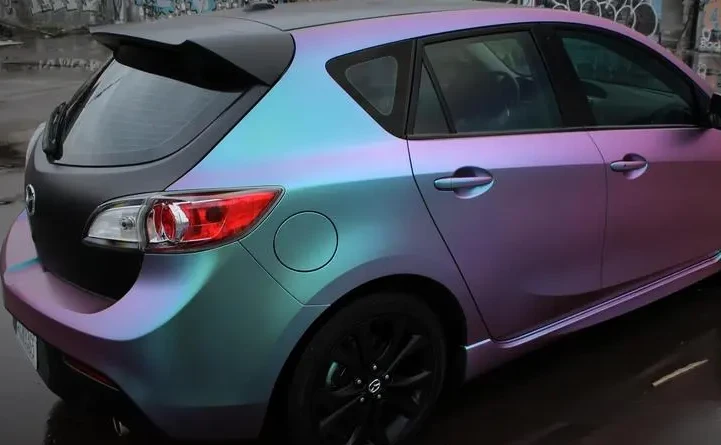How to use Chameleon Paint Powder to prepare Chameleon Paint?
Chameleon paints are named by color changes like chameleon based on surroundings. There are three common types of chameleon paints: optically variable paints, 3D color paints and chameleon paints.
1. Optically variable paints: they are the early chameleon paints. They differ greatly in brightness and color saturation at different angles in the sunlight. But the hue interval is not significant.
Principle of color change: Chameleon paints are made by adding special mica powder into modified metallic paints. Due to the directional reflection of light by special mica sheets, colors of chameleon paints will change at different visual angles.
2. 3D color paints are widely applied in refitting factories. They have colorful effects in the sunlight.
Principle of color change: polygonal mica sheets are added. Color dispersion is produced by multiple refractions of the sunlight, so these paints have colorful effects.
3. Chameleon paints are optically variable paints. With the in-depth development, their colors will change in the presence or absence of sunlight, in additional to color changes at different angles. The principle of color change is similar to that of optically variable paints. Mica sheets are added to achieve the visual effects.

What are the steps for preparing Chameleon paint?
1. Formula for chameleon paint
First, prepare the following formula for chameleon paint:
1. Basic paint (transparent varnish, transparent matte paint, transparent silk paint, etc.): 70%
2. Titanium dioxide: 5%
3. Aluminum powder: 2%
4. Orange pigment: 2%
5. Green pigment: 3%
6. Purple pigment: 3%
7. Diluent: 15%
This is a common formula of chameleon paint. The types and proportions of pigments can be adjusted as needed during the actual production.
2. Steps for preparation of chameleon paint:
1. Pour the basic paint into the vessel, and stir it.
2. Add aluminum powder and titanium dioxide into the basic paint, and stir them.
3. Add orange, green and purple pigments one by one. Fully stir the mixture after adding each pigment, to ensure that pigments are thoroughly dissolved in the basic paint.
4. Add an appropriate amount of diluent. Stir the mixture to the desired consistency.
3. Precautions for preparation of chameleon paint
1. Keep all materials and equipment clean and dust-free, so as not to affect the color.
2. Add pigments one by one, and continuously stir to avoid pigment caking.
3. Constantly try and test the mixture, and adjust the proportions and types of pigments in time based on the actual effect.
4. Apply the paint on an actual object to test the effect.
What is the amount of chameleon paint powder added to paint?
Addition ratio of chameleon:
When coating an object, we start by applying a black or dark primer and follow up with chameleon pigment to create a fascinating color-changing effect. In plastic, it is advisable to mix 0.5%-1% chameleon pigment with 0.02% carbon black to achieve a color-changing effect. The color changing pigment can withstand temperatures as high as 800℃.
Coating: Color-changing pigment dosage: 0.5-25%
Ink: Color-changing pigment dosage: 1%-25%
How to spray chameleon paint?
Chameleon paint spraying is a special automobile painting process. Chameleon paint is named according to the chameleon’s ability to change its color. With the chameleon paint, the automobile color will change at different viewing angles.
Chameleon paint spraying is different from other spraying process. First, clean the object, to ensure a better spraying effect. Apply a layer of black primer. Then, spray chameleon paint. Chameleon paint is a special paint, containing special pigments and additives. It has different color and gloss effects. Control the spraying angle and paint process, so that all parts have the same color changes. Finally, apply a layer of clear varnish, to protect the paint and improve the gloss and durability.
Of course, chameleon paints have some drawbacks. First, chameleon paints are more expensive than ordinary automobile paint. This will increase the costs of automobile painting. Secondly, chameleon paints are not easy to maintain and repair. In case of any scratching or wear, chameleon paints must be repaired by professional automobile beauty shops, and the corresponding costs are high. Chameleon paints can be used for personalized and cool products!
How do you put chameleon pigment car paint on a automobile?
When spraying chameleon pigment car paint, the first pass is to spray the whole car once with a quick, simple pass, until the color is just visible.
The second pass requires spraying the chameleon paint smoothly, without any sags, and with a certain glossiness visible to fully reveal the color-changing effect.
The third pass is for selective and patch spraying only on unsprayed or inconsistently shaded areas.
Note:
When spraying chameleon paint, it is crucial to maintain a steady speed, distance, atomization, and thickness. Any inconsistency in these factors could lead to uneven color depth, color doping, or other unwanted effects.
After applying chameleon pigment, we should let the whole vehicle air-dry in the summer and warm and dry for about 30 minutes during the winter.
When applying a coat of bright oil, it is recommended to use multiple layers of sufficient thickness to enhance the three-dimensional and layered effect of chameleon paint. The thicker the bright oil, the better the reflection.
Pigment for Paint Uses



